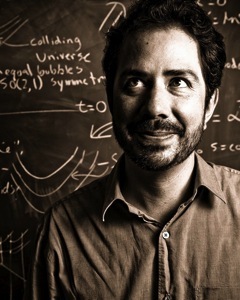Professor Anthony Aguirre
The NewScientist article Is the evidence for “alien” universes all around us? said
“IT HAS long been accepted, at least in theory, that other universes might exist and might even collide with ours. Yet the idea that we would ever be able to see the aftermath of such collisions, and so find evidence of other universes, has seemed beyond the scope of science. That is set to change.Anthony Aguirre of the University of California, Santa Cruz, thinks the proof of cosmic collisions could be all around us, as imprints in the cosmic microwave background (CMB) left over from the big bang.
The usual assumption is that these other universes are disconnected from us, and that we can’t enter them and look around, or observe them in any way. ‘People often criticize discussions of multiple universes as meaningless because we can’t detect whether they actually exist,’ says Aguirre. He doesn’t accept this. Some of these assumptions may be wrong, he says, and other universes could leave behind telltale signs of their existence when they collide with ours. ‘Frustratingly, not much work had been done on the observable consequences of collisions,’ he says.”
Anthony Aguirre, Ph.D. is Associate Professor of Physics, University of California, Santa Cruz. He is also Cofounder & Associate Scientific Director, The Foundational Questions Institute.
Anthony’s current research falls into three main categories.
The first and largest is the study of:
Cosmological inflation and eternal inflation. Inflation is a compelling component of the standard model of cosmology with considerable observational success. Eternal inflation, which is generic in inflation models, describes a situation where inflation goes on forever, ending only locally and thus continually creating “pockets” or “bubbles” of non-inflation that might have diverse properties and one of which might contain our observable universe.
He’s studied a number of questions in this scenario including:
- If inflation goes on forever, might it have been going on forever, so there is no real “beginning of time”?
- What is the large-scale structure of an eternally inflating universe? What does it say about the “arrow of time”?
- How exactly do bubble and pocket universes form? How do transitions between different “vacua” (which describe the possible properties of these regions) occur?
- If we live in such a “multiverse”, there are no unique predictions of what we should see. How, then do we test such theories or scenarios? Can this be done statistically, by determining which sorts of properties are rare versus common?
- Are there possibilities for obtaining direct evidence for other pockets or bubbles?
A second set of research focuses on:
Heavy-Element Enrichment of the Intergalactic Medium. Heavy elements, such as silicon, oxygen, and carbon (or “metals” in astro-parlance), are formed inside stars, which are located in galaxies. Yet, these elements are also observed in the “intergalactic medium” between galaxies.
- How much metal is out there?
- How did it get there?
- What does this process tells us about galaxy formation and evolution?
A third set of current research is:
Dark Matter and the First stars: The first (“Population III”) stars, unlike later stars, each form in their own dark matter halo. This dark matter, if it is of the “WIMP” variety, can interact with itself, and annihilate to release energy, but only very rarely. As it turns out, however, these halos can be so dense that the energy generated by dark matter can actually rival all other heat sources in the objects — including nuclear fusion! Thus the first stars may, in fact, have a quite different structure than generally supposed, and might even live for a time as “dark stars” fueled by dark matter.
Anthony authored Where Did It All Come From?, Eternal Inflation, Past and Future, On making predictions in a multiverse: conundrums, dangers, and coincidences, Alternatives to Dark Matter (?), Dark Matter in Cosmology, and coauthored How Did the IGM Become Enriched?, Surviving the crash: assessing the aftermath of cosmic bubble collisions, Dark Stars: Dark Matter in the First Stars leads to a New Phase of Stellar Evolution, and Towards observable signatures of other bubble universes II: Exact solutions for thin-wall bubble collisions. Read the full list of his publications!
Anthony earned his B.S. in Mathematics/Physics at Brown University in 1995, his M.S. in Astronomy at Harvard University in 1998, and his Ph.D. in Astronomy at Harvard University in 2000.
